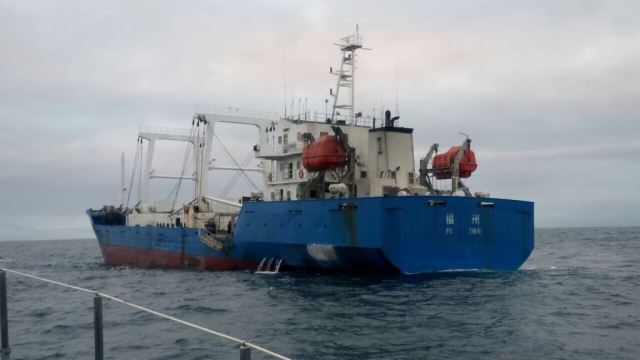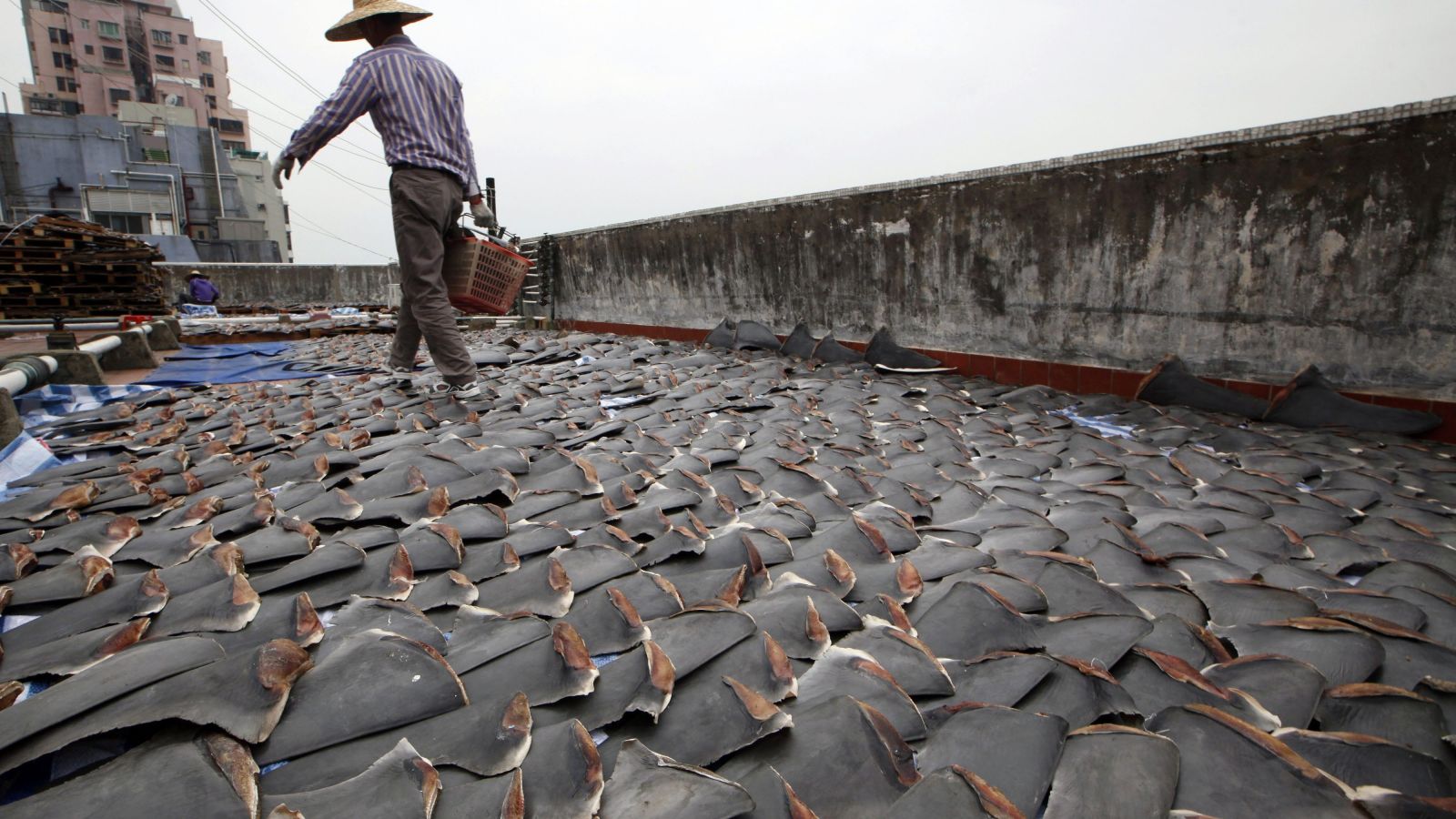On Aug. 13, Ecuadorian authorities intercepted a Chinese ship crossing the Galapagos Marine Reserve, one of the most heavily protected nature reserves in the world. In its freezers they discovered 300 tons (270 metric tons) of fish, of which more than half were sharks—mostly illegal hammerheads and threatened silky sharks.
Yet the Fu Yuan Yu Leng 999 was not a fishing boat. Its crew, who now face jail time in Ecuador for environmental crimes, were likely not the fishermen. To fish commercial quantities of shark, you need tens of thousands of meters of thick fishing line, big, motorized winches, and piles of hooks, each the size of an adult finger. That sort of gear was not on board.
Rather, the Chinese ship was a carrier vessel, whose job was to collect and deliver to port the illegal catch of other fishing boats. Its capture, likely one of the biggest seizures of illegal sharks in recent years, opens a rare window into the murky world of maritime poaching. And it has triggered an international hunt to piece together the puzzle: Where was it heading? Who was making money off of the smuggling? And, most of all, who were the fishermen and where did they catch the sharks?

Tracking the smugglers
The Galapagos islands are nearly 600 miles (960 km) west of the Ecuadorian mainland. The waters around them, the Galapagos Marine Reserve, are a UNESCO World Heritage Site known for the largest abundance of sharks in the world. They are part of a marine corridor spanning the Eastern Tropical Pacific, all the way up to Cocos Island in Costa Rica. Many sharks migrate along the corridor, leaving them exposed to fishing fleets waiting outside the reserve’s protected waters.
Throughout the corridor, shark fishing is driving local species like hammerheads towards extinction, according to a Costa Rican marine biologist, Geiner Golfin. “The illegal markets continue to grow in order to satisfy the expensive Asian dish, shark fin soup, which is made up of tasteless strips of cartilage or noodles from the fins,” he wrote in an email.
Shark fishing outside of the Galapagos Marine Reserve is not always poaching: shark fishing as bycatch is legal in most of Ecuador’s Exclusive Economic Zone, extending 200 nautical miles (370 km) from its coast. So is selling the meat and fins on national and international markets. But fishing or even transporting scalloped hammerheads (Sphyrna lewini) in Ecuador’s waters is always illegal.
Ecuador’s environment ministry identified hammerheads in the haul from the Fu Yuan Yu Leng 999, and several experts independently verified from photos that the catch included scalloped hammerheads, which are an endangered species. Under Ecuadorian law, hunting, fishing, transporting, or possessing an animal in danger of extinction can carry a three-year prison sentence.
The ship was caught because the authorities spotted a signal from its Automatic Identification System (AIS)—a type of GPS transponder that, by international convention, all large commercial ships must carry. Ships are known to turn AIS off (pdf) to evade detection, and nobody knows why the Chinese vessel had its system on. (“To us that seems like madness” given the marine reserve’s security systems, says Jorge Durán Herrera, an Ecuadorian navy captain, who spoke to us by phone.) This video from the Galapagos National Park authorities shows the path it took through the reserve:
However, the AIS data from the Chinese ship shows no evidence that it stopped to take on a transshipment of fish while it crossed the reserve. So where could the sharks have come from? There are a couple of theories.
The “ghost poachers”
After the Chinese ship was seized, aerial reconnaissance missions by the Ecuadorian navy found a fleet of more than 100 foreign fishing vessels—many of which were too small to have AIS systems—in international waters just to the south of the reserve. Pelayo Salinas, a marine ecologist from the reserve’s Charles Darwin Research Station, wrote to us that, “based on the trajectory of the boat” and locations of those fishing boats, he thinks the sharks were likely fished near the Galapagos.
Bolstering that theory, the shark species on board are abundant in the waters around the islands, and there were young and baby sharks in the haul, said Ecuador’s environment minister. That shows the catch could have even been from within the Galapagos reserve itself, since it is an important hammerhead breeding ground.
But there are other possibilities. “This ship sailed from Asia in April,” Walter Bustos, Director of the Galapagos National Park, said in a phone interview. Sharks, which tend to be solitary hunters, congregate in two primary spots along the Fu Yuan Yu Leng 999’s route: off the coast of Asia and near the Galapagos. The transfer to the Chinese ship could have happened anywhere on that route, Bustos said, and only DNA testing will reveal for certain whether the sharks came from the western or eastern Pacific.
Entities such as the Galapagos Park Rangers and the non-profit organization Global Fishing Watch have access to historical AIS data and could feasibly map the journey the smugglers took before reaching the Galapagos. It might show the vessel pausing to rendezvous with other ships. But since many fishing vessels are too small to carry AIS, they themselves wouldn’t be visible.
Wherever it took place, such a transfer at sea, known as transshipment, would have been unauthorized. Under multi-national conventions in the western (pdf) and eastern (pdf) Pacific, only certain vessels may receive transshipments of fish from fishing boats. The Fu Yuan Yu Leng 999 is on neither treaty’s list. In fact, as China is a signatory of the Convention on International Trade in Endangered Species, for a Chinese vessel to even carry scalloped hammerheads that have been transshipped is illegal without a “non-detriment finding” (NDF), a permit for exporting species that the convention lists as threatened. The crew of the ship didn’t present such a permit when they were boarded.
And a look at the vessel’s ownership suggests that the Fu Yuan Yu Leng 999 may be involved in a wider nexus of fishing.
The question of ownership
The ship is registered to a China-based company, Fuzhou Honglong Ocean Fishing, according to International Maritime Organization records. In 2013 Hong Long sold 46 ships and licensed 20 more to a larger company, Pingtan Marine Enterprises, according to a 2013 SEC filing (pdf, p. 10) as well as a 2014 class-action lawsuit (pdf). Pingtan’s CEO and majority shareholder, Xinrong Zhuo, and Hong Long’s majority shareholder, Ping Lin, are husband and wife, according to those documents. Pingtan’s website lists more than 140 Fu Yuan Yu vessels that it owns or leases from Hong Long, though the Leng 999 isn’t on the list.
A Pingtan representative reached by phone denied that Pingtan owns the Fu Yuan Yu Leng 999, that Zhuo or any subsidiaries have an economic interest in it, or that Hong Long is a related company. “Your databases are wrong,” he said.
A report by research firm Aurelius Value in May suggests Pingtan is implicated in human trafficking and shark poaching in East Timor, as well as fraudulent financial activity in which it purchased the CEO’s own vessels for inflated prices. Earlier this year, a class-action lawsuit (pdf), which cites the Aurelius report, was filed in the US against Pingtan on behalf of investors, alleging that the company made false and misleading claims about the value of its shares.
No matter who owns the Fu Yuan Yu Leng 999, the Ecuadorian authorities say its capture provides an example to the world. “We demonstrated that we have the capability to capture that kind of vessel,” said Bustos. “Ecuador was the first country in the world that declared not only human rights, but nature rights, since 2008, in our constitution. So we are obligated to protect the lives of these fish.”
Written by Katarina Zimmer & Sarah Blaskey
Source:
Quartz
Footnote:
Contact Seal Superyachts Galápagos Islands for detailed information about cruising around Galápagos Islands, superyacht charter regulations and about how we can support your visit.
Principle agent Antonio Moreano is proud to have worked with many of the World’s largest Superyachts and has extensive knowledge of Galápagos Islands and the surrounding area.
Antonio Moreano
Phone: +593 999 11 6066
Email: antonio@seal-superyachts.com
